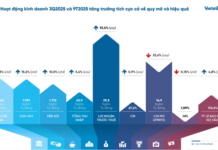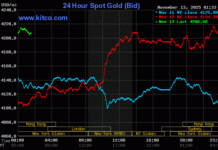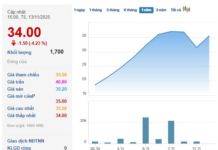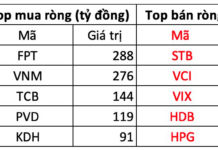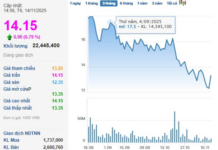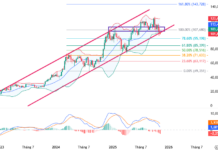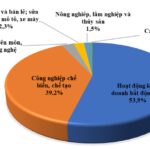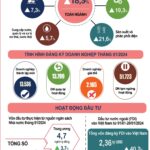TS. Cấn Văn Lực and the Research Group of BIDV Training and Research Institute have released a comprehensive report on Vietnam’s economic performance for the first half of 2024 and forecasts for the full year. We are pleased to share this detailed report with our valued readers.
—
Global Economic Context for the First Half of 2024
The world economy in the first six months of 2024 was largely stagnant, with a slow and uneven recovery. There were divergences among countries and between the service and manufacturing sectors. Inflation has cooled significantly (although still far from the target of many countries) due to stable or slightly increasing commodity prices, and the basic recovery of supply chains, creating a premise for central banks to lower interest rates to support economic growth and ensure the stability of the global financial market (such as Switzerland’s interest rate cut in March 2024, Canada and ECB in June 2024, and Fed’s expected cut in September 2024, along with many other central banks considering similar moves).
However, the global economy still faces numerous risks and challenges due to prolonged and unpredictable geopolitical tensions (conflicts in Ukraine, the Red Sea, and the Middle East), political situations in some countries during and after elections, increasing competition among major economies in trade and technology, rising trade protectionism and fragmentation, high interest rates, debt risks, and input costs, which slow down the recovery pace, as well as persistent energy and food security risks, and more unpredictable and extreme climate change impacts.
Regarding the outlook, international organizations (WB, IMF, ADB, OECD, UN…) have updated their forecasts, projecting global GDP growth of 2.6-3.2% in 2024-2025, similar to 2023 levels. Inflation (CPI average) is expected to cool down to around 4% in 2024 and 3-3.5% in 2025. Global trade is forecast to recover, increasing by 2.5-3.3% in 2024-2025 (up from 0.4% in 2023), while FDI investment is expected to slightly improve (growing by approximately 2-3% in 2024-2025).
Vietnam’s Economic Picture for the First Half of 2024
Against this global economic backdrop, Vietnam’s economy in the second quarter and the first half of 2024 achieved positive results, recording eight bright spots as follows:
First, the National Assembly and the Government continued their efforts to improve the institutional framework, address difficulties and obstacles, and prioritize economic growth.
In terms of institutional improvement, the National Assembly passed several important laws and resolutions, creating a synchronized legal corridor and removing institutional barriers. Notably, the resolution allows the Land Law 2024, the Housing Law 2023, and the Real Estate Business Law 2023 to take effect from August 1, 2024, five months earlier than initially planned. The Government has also issued numerous decrees, resolutions, and directives, while ministries and sectors have promulgated circulars to guide the implementation of the enacted laws (especially the Laws on Medical Examination and Treatment, Bidding, Pricing, Electronic Transactions, Land, Housing, Real Estate Business, and Credit Institutions…) to promptly resolve bottlenecks and unlock resources for socio-economic development.
At the recent seventh session, the National Assembly also passed 11 laws (including notable ones such as the amended Law on Auction of Assets, the amended Law on Social Insurance, and the amended Law on the Capital City…) and a resolution on special mechanisms for Da Nang and Nghe An. Additionally, many resolutions and solutions have been issued and actively implemented to address challenges in the land, real estate, finance, healthcare, tourism, and energy markets.
Fiscal policy has been directed towards reasonable expansion, focusing on key areas to promote public investment disbursement, three national target programs, and harmonious coordination with monetary policy to boost growth, control inflation, and ensure macroeconomic stability. Accordingly, the National Assembly and the Government have approved numerous policies and financial support packages through tax reductions, extensions, and fee exemptions for 2024, totaling approximately VND 185,000 billion in nominal value, equivalent to a reduction in state budget revenue of VND 68,000 billion (nearly reaching the levels during the COVID-19 pandemic).
Monetary policy has been flexible, proactive, timely, and effective, striking a balance between growth and inflation, interest rates, and exchange rates, in close coordination with fiscal policy. The Government and the State Bank of Vietnam (SBV) have introduced numerous policies to promote credit growth, control credit quality, reduce lending rates, enhance businesses’ access to capital, and allow debt restructuring (maintaining the same debt group) until the end of 2024. They have also promoted cashless payments and used multiple tools to stabilize exchange rates and the gold market, along with issuing many decrees and circulars to guide the implementation of the Law on Credit Institutions 2024.
Regarding digital transformation and administrative reform, various policies and solutions have been implemented to accelerate the realization of Proposal 06 on developing a national database and electronic identification and authentication for digital government. Efforts have been made to expedite digital transformation in ministries, sectors, and localities, reduce and simplify administrative procedures, and enhance the integration of public services on the National Public Service Portal.
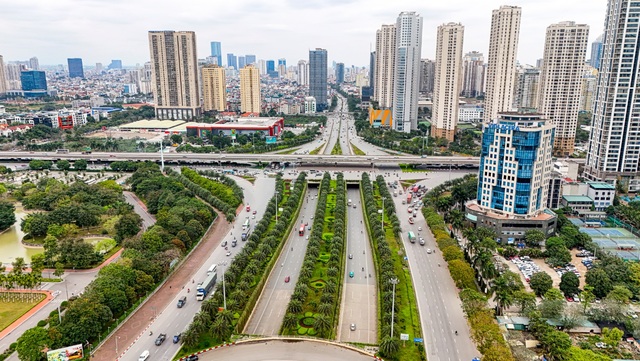
Vietnam’s economy shines with eight bright spots in the first half of 2024 (illustrative image: Ngoc Dep)
Second, GDP growth in the second quarter is estimated at 6.93% and 6.42% for the first half, higher than the target set in Resolution No. 01. Both supply-side and demand-side growth drivers showed positive improvements. On the demand side, import and export turnover increased by 15.7% (a significant recovery from the -15.2% decline in the first half of 2023 and higher than the 9% growth in the first half of 2019). The trade balance surplus reached USD 11.6 billion, contributing to exchange rate stability and foreign reserve accumulation.
FDI attraction and disbursement continued to improve. In the first half of 2024, the total registered FDI capital in Vietnam was estimated at USD 15.2 billion, an increase of 13.1% over the same period last year. FDI disbursement reached USD 10.84 billion, up by 8.2% compared to the first half of 2023, marking the highest growth rate compared to the same period in the last six years (in the first half of 2019, FDI registration decreased by 9.2%, while disbursement increased by 8.1%; in the first half of 2023, FDI registration decreased by 4.3%, and disbursement increased slightly by 0.5%). These positive results affirm investors’ confidence in Vietnam’s growth prospects and its opportunities arising from global supply chain shifts.
Consumption continued its recovery with total retail sales of goods and services in the first half of 2024 increasing by 8.6% over the same period last year, driven by a strong rebound in tourist arrivals (8.8 million international visitors, up by 58.4% compared to the first half of 2023 and 4.1% compared to the first half of 2019). The positive momentum in retail sales, along with government consumption, contributed to final consumption being the highest contributor (64.26%) to GDP growth in the first half of the year. However, the growth rate of retail revenue was still lower than in the first half of 2023 (11.3%) and pre-pandemic levels (the first half of 2019 saw a 10.8% increase).
Public investment disbursement achieved positive results, although uneven and slow, while private investment recovered. The total disbursed capital in the first six months was estimated at VND 244,410 billion, accounting for 33.8% of the yearly plan and an increase of 3.5% over the same period last year. Private investment increased by 6.7%, triple the growth rate of 2.1% in the first half of the previous year. However, the pace of public investment disbursement was still slower than in the first half of 2023 (+4.2%) and the first half of 2019 (+22.5%). Some ministries, sectors, and localities had very low public investment disbursement rates, requiring more determined efforts in the remaining months of the year.
Industrial production (IP) recovered positively. In the first half of 2024, the IP index increased by 7.7% over the same period last year (compared to a decrease of -1.2% in the first half of 2023 but still lower than the 9.5% growth in the first half of 2019) due to rising exports and domestic demand. The PMI manufacturing index reached 54.7 points in June 2024, a significant improvement from 50.3 points in May 2024, 50.5 points in June 2023, and 52.5 points in June 2019, marking the highest level since May 2022, thanks to positive developments in new orders, exports, and business confidence. However, the recovery of industrial production was uneven, as many industries faced challenges related to production conditions, rising input costs, and low participation in industry value chains.
Third, the macroeconomy remained stable, and inflation was kept under control, despite rising input prices (the industrial production index – PPI increased by 0.25%, and the service production price index rose by 7% compared to the same period last year) and gradually increasing demand-pull inflationary pressure (credit growth in the first six months was estimated at 5.2% compared to the beginning of the year, and money velocity stood at 0.65 times, equivalent to 0.64 times for the whole of 2023). The average CPI in the first half of 2024 increased by 4.08%, and core inflation averaged a rise of 2.75% over the same period, lower than the increase in the first half of 2023 (4.74%). However, inflationary pressures persist, especially with the expected increase in the prices of many goods and services managed by the State (base salary, healthcare, education, electricity…).
Fourth, interest rates remained stable, and credit recovered: deposit interest rates increased by 0.5-1% since the beginning of the year, while lending rates remained largely stable. In the first half of 2024, credit is estimated to have grown by 5.2% compared to the end of 2023, a significant improvement from the 2.41% growth at the end of May 2024 and higher than the 3.36% growth in the first half of 2023, driven by the recovery in investment, consumption, and the real estate market. Credit growth for the whole year is projected to reach 13-14%, in line with macroeconomic developments, demand, and the economy’s absorption capacity. The stock market grew positively (the VNIndex increased by 10.2% from the beginning of the year, equivalent to the 11.2% growth in the first half of 2023 and higher than the 6.43% growth in the first half of 2019), along with economic growth and improved corporate health (market-wide profits are estimated to have increased by 9.5% over the same period last year); the corporate bond market and the real estate market are gradually recovering.
Fifth, state budget revenue increased significantly, in line with the recovery in production and consumption. State budget revenue in the first half of 2024 reached VND 1,021 trillion, equivalent to 60% of the annual estimate, an increase of 15.7% over the same period last year; state budget expenditure decreased slightly by 0.1% compared to the same period, partly due to the slow disbursement of public investment in some ministries, sectors, and localities. The state budget surplus was VND 216.4 trillion, triple the surplus in the first half of 2023, providing fiscal space to support people and businesses. The major economic balances were ensured, with public debt, foreign debt, and budget deficit remaining below the average levels of the world and other developing and emerging countries; the government’s debt repayment obligations were below the National Assembly’s threshold; food security, energy security, social security, and people’s livelihoods were guaranteed. Thanks to these positive developments, S&P Global Ratings, on June 20, affirmed Vietnam’s long-term rating at Stable and projected a potential growth recovery to 6.5-7% in the 2025-2030 period.
Sixth, planning and investment in infrastructure development continued to receive attention and promotion. Socio-economic development planning, sectoral and regional planning until 2030, with a vision towards 2045 or 2050, have been formulated for many regions and localities. The plan to implement Power Development Plan VIII has been issued, 5G technology has been successfully tested, and the progress of airport and expressway projects has been accelerated, creating favorable conditions for socio-economic development in the short and long term.
Seventh, external affairs and international integration activities were further promoted. High-level visits between Vietnam and China, South Korea, Russia, and other countries, along with active participation in important multilateral forums such as the United Nations, ASEAN, the World Economic Forum (WEF) Dalian 2024, and the ASEAN Future Forum (AFF) 2024, have continued to enhance Vietnam’s international position and prestige. These activities also create opportunities to promote economic cooperation, trade, investment, and tourism in the coming time.

Planning and investment in infrastructure development received attention in the first half of 2024 (illustrative image: Ngoc Dep)
Six Key Risks and Challenges
However, Vietnam’s economy still faces six key risks and challenges.
First, the four external risks and challenges remain present, including: (i) prolonged and unpredictable geopolitical crises (especially conflicts in Ukraine, the Red Sea, and the Middle East), (ii) complex strategic competition in trade and technology among major countries, leading to increased trade fragmentation and protectionism, (iii) inflation and interest rates have decreased but remain high, and fiscal risks and debt levels are high, causing slow and unsustainable global economic recovery, and (iv) energy security, food security, and natural disasters and extreme climate events remain constant threats.
Second, some traditional growth drivers have recovered but remain uneven, low compared to pre-pandemic levels, and not yet sustainable. The growth rate of total retail sales of goods and services (excluding price factors, with a 5.7
4 Factors Putting Pressure on USD/VND Exchange Rate in Q1/2024
With the currency exchange rate fluctuating in the first few weeks of 2024, Mr. Ngo Dang Khoa, Director of Foreign Exchange, Capital Markets and Securities Services at HSBC Vietnam, highlights four factors putting pressure on the USD/VND exchange rate in Q1/2024…
Vietnam’s Economic Landscape in the First Month of 2024
In January 2024, the country witnessed the reactivation of nearly 13.8 thousand businesses, which is 2.2 times higher than December 2023 and represents an 8.4% decrease compared to the same period in 2023. This resulted in a total of over 27.3 thousand newly established and reactivated businesses in January 2024, marking a 5.5% increase from the previous year.
Territory-based credit policy in Ho Chi Minh City shows nearly 39% growth
Credit programs, not only support and assist the poor and vulnerable, who are the main subjects of policies in Ho Chi Minh City, with capital for production and business to create livelihoods and employment opportunities, but also play a significant role in the direction of sustainable economic development, economic growth, and social security ensured by the Government.






